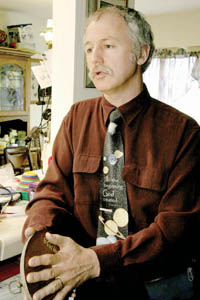In the last year, Silicon Valley has been a center of a
showdown over religious beliefs in public schools. Meet the other side.
LYNN HOFLAND often talks faster than he thinks. For Hofland,
it seems the circumstances demand it. A creationist, he happily espouses a
point of view that mainstream culture considers ridiculous and unenlightened.
The earth, according to Hofland, is about 6,000 years old.
God created it in six 24-hour days. And, of course, evolution is just a theory.
Most people around here will shake their heads and wonder
how anyone could think that in this day and age. But for Hofland, it's a basic
foundation of his belief system.
And his belief system came to the South Bay in a big way
last fall when Stephen Williams, a fifth-grade teacher at Stevens Creek Elementary
School in Cupertino, filed a federal civil rights lawsuit against the Cupertino
Union School District (and against Stevens Creek Elementary's principal),
claiming he had been discriminated against because he was Christian. Williams,
backed by the Alliance Defense Fund, a Christian legal organization engaged in
contesting cultural issues across the nation, said that his principal stopped
him from handing out historical materials in class that referenced God. After
an initial Drudge Report headline about the Declaration of Independence being
"banned" at a California school, Williams' case was egged on by
right-wing radio and blogs. Sean Hannity, of Fox News' Hannity & Colmes,
brought his show to the Flint Center in Cupertino for a special "Take Back
America" broadcast.
Mark Thomas was one of the panelists for that broadcast.
Thomas, the president of the Atheists of Silicon Valley (www.godlessgeeks.com),
believes everything that Hofland does not. He believes men came from monkeys.
He believes the animate sprung from the inanimate; the concept even has a
scientific-sounding word for it: abiogenesis.
Thomas has met Hofland on more than one occasion; he even
went so far as to give Hofland the floor during one of his atheist meetings
held bimonthly in the community room of his townhouse complex in Mountain View.
But the truth is, he thinks Hofland is a kook. Or, if Hofland's not a kook
himself, that his ideas about the origins of life are definitely kooky.
"It's rather irritating to get into these conversations
about the origins of life with him," says Thomas. "You keep coming
back with God did this, God did that. The problem is for him there are no
contradictions because he's right. In some ways you can't refute him. God could
have created the world a hundred years ago with everything looking as though it
were ancient. You can't disprove it. God could have created the universe a day
ago with everything, including people's memories intact. You can't disprove
that."
Evolution of an
Anti-Evolutionist
Hofland may think the world was created in six days, but it
took him a lot longer than that to arrive at that belief—30 years and then
some, in fact. Born in Montana, near Missoula (he still mixes Montana wheat
into homemade breads and waffles), Hofland, now 50, has always had a Midwestern
sensibility. He graduated from high school (his mother was his eighth-grade
biology teacher), but flunked out of college after a year and a half. Then, he
did a six-year stint in the Navy, floating around the South Pacific on a
nuclear submarine.
"My background," he admits, "did not lend
itself to me being a creationist."
Of all things, it was a subsequent job at NASA, where he's
still employed today, that led Hofland to discard the evolutionism he had grown
up with. Watching NASA scientists taking lessons from the physiology of
giraffes to develop gravity suits for astronauts (the thick-skinned giraffe
boasts a unique blood pressure for mammals, which is especially helpful for
outer-space modeling) eventually convinced Hofland to do his own research into
the giraffe—an animal, as it turns out, that has been widely used in
creationist arguments.
What he found, he says, converted him. The giraffe, he
learned, has seven neck bones (the norm, for many mammals), even though, as far
as he could tell, there's no reason why evolution wouldn't have demanded the
number of the giraffe's neck bones increase with the size of its neck. Hofland
was also amazed at the giraffe's capability to withstand extreme blood pressure
(due to its height) in its legs, and to adjust the pressure when it bends its
head down to drink water—without its reinforced artery walls, its collection of
valves and a "web" of small blood vessels, intense pressure would
reach the giraffe's brain every time it bends its head. Not to mention what
Hofland considers the miraculous design of the giraffe's birthing process—the
new calf, which drops into the world from a height of five feet, cannot fall
neither head or feet first, as both positions would end up breaking its neck;
instead, the giraffe maneuvers a "perfect" exit, hind feet first and
supporting its flexible neck around its shoulders.
Before he learned all this, Hofland insists, he, always
scientifically inclined, was very much an ardent evolutionist. But, after his
study, he ended up penning an article which became the basis for a new
creationist ministry he calls Stiffneck Ministries.
"I had to struggle with this, but when I did my
homework, I was convinced the giraffe was created," he says. "And, if
the giraffe was created, then I was created, and, if I was created, then I had
some answering to do for my life."
Thomas, however, is hardly impressed by Hofland's
conversion. "I'm very well aware of his Stiffneck Ministries and his
giraffes," says Thomas, with an exasperated tone. "His arguments are
false; they are completely false. Giraffes have evolved over a period of time,
and it's not a very good system. Giraffes have a lot of problems, many babies
die during birth because they have a long distance to fall, but it works well
enough for them to survive."
Thomas has little patience for Hofland's logic. "What
creationist and intelligent designers like to point out is, basically, 'Isn't X
amazing? I don't understand how X could be. Therefore, there must be something
else that designed X and that created X. I don't understand what this other
thing is either, but it must exist, because I don't understand X. That's
fallacious reasoning."
Putting God Into Schools
Hofland was in the audience for the Hannity special in
Cupertino. For him, the hubbub was about nothing other than certain people—in
this case, the elementary school's administrators and the concerned
parents—being too "sensitive." The United States, Hofland likes to
say, is largely a Christian nation, though Hofland's definition of what a
"Christian" nation is seems to vary subtly with the context.
Sometimes, as in the case of Cupertino's Williams, who Hofland argues was only
distributing material that reflected the roots and realities of the United
States, the nation's very Christian; sometimes it's not Christian enough.
Even the question of what "Christian" belief is in
regard to creationism has shifted over time.
"The irony, of course, in all of this creation science
stuff is that modern conservative Christians are not the equivalent of their
19th-century counterparts," says J. David Pleins, a professor of religion
at Santa Clara University.
Pleins, who has written extensively about readings of
Genesis, argues young earth creationism—Hofland's view of a 6,000-year-old
history—wasn't always a traditional Christian perspective.
"In the 19th century, you people who we would today
call fundamentalist or conservative Christians, who didn't think the earth was
young. They were anti-evolution Christians; they were against Darwin, but they
believed the earth was old because they believe that the science told us about
all these ancient lost eras. And so you had conservative Christians who were
committed to an old-earth creationism. That seems to be an option that's lost
today, and it's lost not because of the Scopes trial."
Instead, Pleins contends that a book, The Genesis Flood, put
young earth creationism on the map. "It argued that science, rewritten and
interpreted differently, would validate a literal reading of the Bible, so with
creation science, you get a commitment from all conservative Christians
committed to a young earth reading of the text. That's new."
The reasons behind the shift in perspective are strikingly
similar to the modern fundamentalist worries that Christianity would erode away
if not somehow protected, which results in a defensive posture by the Christian
right in the American culture wars. The book's authors, says Pleins, thought
that "if you give away the literal reading of the Bible, you start giving
up the biblical truth. Where would you stop?"
Similarly, Hofland wants to establish the Bible's authority
in America's public schools.
"There's nothing wrong with the Bible being added as a
reference text," he insists. "If the science classroom is asking
questions about how old the earth is, then this"—Hofland pats a tiny blue
Bible—"is as good of a reference as rocks in the ground."
Employing Hofland's logic, solutions for teaching evolution
in public schools would, seemingly, become exercises in political correctness.
"Question number one," Hofland says, "could
be according to the theory of evolution; question number two could be according
to the theory of creation; question number three could be according to the
Buddhism or whatever. Or something like that."
Hofland may seem to be far out of the mainstream, but his
beliefs have made some inroads in popular culture, as seen in cases like that
of the Atlanta school district that voted in 2002 to put stickers in biology
textbooks which stated that evolution is "a theory not a fact." A
federal judge ruled that the stickers had to be removed.
Others who criticize the way evolution is taught in public
schools say they aren't necessarily creationists, but simply believe God has
been pushed too far out of the debate over life's origins. In 1998, after receiving
a letter co-signed by two widely respected religious scholars, Huston Smith and
Alvin Plantinga, the National Association of Biology Teachers was forced to
edit its definition of what to teach about evolution in schools. The
association had described evolution as "unsupervised" and
"impersonal"; Smith and Plantinga argued there was no scientific
basis for those descriptors, and the association ended up agreeing, deleting
the two words.
At NASA, Hofland often visits an artistic depiction of the
origins of human life that has been put up in a building neighboring his
workspace. The depiction, a colorful painting that, from left to right, shows
the evolutionary stages of life through bold white lines. It begins with
volcanoes exploding, moves on to micro-organisms in the oceans, to various
kinds of mammals in the forests, to cave men, and finally to modern man driving
along a highway.
"I did meet the artist, the original artist," he
says of the painting. "At first, he told me they told him to paint all the
volcanoes exploding. Then, they told him, Oh that was too much, that would
cause a nuclear winter and shut everything down, so they only had two volcanoes
that were exploding and the rest were dormant. And see, they keep changing
their view of what happened."
http://www.metroactive.com/papers/metro/04.20.05/creationism-0516.html
 Photographs by Felipe Buitrago
Photographs by Felipe Buitrago  Tie For First: The way Lynn Hofland's neckwear pointedly
quotes the opening of the Christian Bible leaves no doubt as to where he stands
on the question of life's origin.
Tie For First: The way Lynn Hofland's neckwear pointedly
quotes the opening of the Christian Bible leaves no doubt as to where he stands
on the question of life's origin.